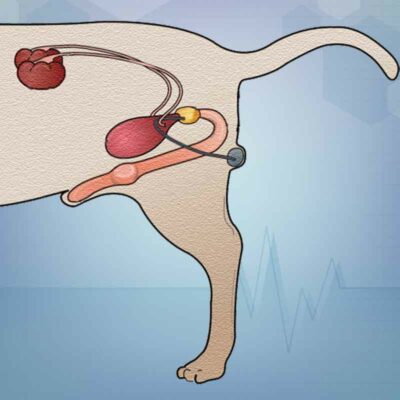 Urinary and reproductive system diseases in dogs
Urinary and reproductive system diseases in dogs
The urinary and reproductive systems exhibit a close association, with infections in one system easily spreading to the other. The urinary tract possesses features that contribute to infection prevention.
Valves at the entry point of the ureters into the urinary bladder normally prevent the backflow of urine to the kidneys, thereby safeguarding the kidneys from lower urinary tract infections. The acidity of urine provides some antimicrobial properties, and the flushing action of urine to the exterior further aids in preventing microorganisms from causing infection.
Due to the proximity of the anus to the female urethra, it is not uncommon for the urinary tract to be contaminated with intestinal bacteria, notably Escherichia coli, Proteus spp., and other gram-negative bacteria. The fungus Candida albicans also acts as an opportunistic agent in urinary tract infections, and many such infections are nosocomial.
In contrast, the reproductive system is largely free of microorganisms, except for the female vagina. Lactobacilli are present in the female vagina shortly after birth due to the transfer of estrogens from maternal to fetal blood. The pH of the vagina becomes more neutral until puberty, when estrogen levels rise, lactobacilli once again dominate, and the vagina becomes acidic. Throughout the reproductive years, small numbers of other bacteria and fungi become part of the microbiota.
Don’t forget, if you’re ever in doubt, always contact your local vet for help!
Kidney diseases in dogs
Kidney disease is a prevalent issue among dogs, and safeguarding your canine companion from this condition necessitates early problem detection. Identifying problems early is crucial, given that dogs can develop kidney disease due to various underlying reasons, and unfortunately, it is often challenging to recognize.
In essence, kidney disease in dogs occurs when the kidneys fail to perform their filtering function effectively. The kidneys play a vital role in eliminating waste products from the blood; if they are not functioning properly, these waste products can accumulate in the bloodstream.
The initial indicators of kidney disease in dogs typically involve increased urination and, consequently, heightened thirst. Other symptoms tend to become apparent only when approximately two-thirds of the kidney tissue is compromised.
Keep an eye out for the following signs of chronic kidney disease in dogs:
- Increased water consumption and more frequent urination
- Weight loss
- Loss of appetite and/or nausea
- Presence of blood in the urine
- Detection of protein in the urine (a urinalysis test conducted by your vet can confirm this)
- Unpleasant breath
Glomerulonephritis
The leading cause of glomerulonephritis is the trapping of antigen-antibody complexes (like toxins or enzymes) within the glomeruli, provoking an immune system response and inflammation.
This condition is severe and, when untreated, can progress to chronic kidney disease and failure. Fortunately, there are available treatments that can slow down its progression or even prevent kidney failure in some instances. Hence, it’s vital for dog owners to comprehend glomerulonephritis in dogs and recognize its signs.
To prevent the advancement of glomerulonephritis into kidney failure, dog owners should be aware of its symptoms in dogs:
- Abdominal swelling
- Breathing difficulties
- Elevated temperature
- Frequent urination
- Fatigue and lethargy
- Increased thirst and excessive drinking
- Vomiting
Kidney failure (Renal failure)
Renal or kidney failure in dogs poses a life-threatening situation and always necessitates veterinary attention. When your furry friend experiences renal failure, their kidneys cease to function properly, triggering a rapid decline in overall health.
There are two primary categories of renal failure observed in Orange County dogs:
- Chronic Renal Failure
This type involves a gradual decline in kidney function occurring over weeks, months, or years. It’s often associated with aging-related degeneration. While each dog’s kidneys have a natural lifespan, some may deteriorate faster. Although full recovery from chronic renal failure is unlikely, successful management of this condition for several months or even years is possible. - Acute Renal Failure
Here, a sudden decrease in kidney function happens within hours or days. Typically caused by infections or exposure to toxins, this form of kidney failure requires prompt diagnosis and treatment. Early intervention can often lead to a cure for acute renal failure.
Kidney (Renal) failure in dogs can arise from various conditions that affect the kidneys and related organs, including:
- Bacterial infections
Dogs exposed to contaminated water, through swimming or drinking, may face bacterial infections such as leptospirosis. These infections can inflame the kidneys and cause renal cell damage. - Congenital disease
This encompasses underlying illnesses and hereditary conditions like agenesis (being born without one or both kidneys) and cysts. - Dental disease
Accumulation of bacteria on the teeth and gums can progress to advanced dental disease. At this stage, bacteria can enter the bloodstream, attacking multiple organs, including the kidneys, heart, and liver, causing irreversible damage. - Geriatric degeneration
As dogs age, cellular breakdown occurs throughout their bodies, including the kidneys. This breakdown can result in kidney disease and eventual renal failure. - Toxicosis
Ingestion of poisons or toxins can harm cells within the dog’s kidneys, leading to damage.


